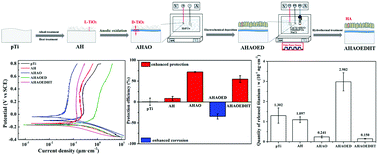Evaluation and regulation of the corrosion resistance of macroporous titanium scaffolds with bioactive surface films for biomedical applications†
Abstract
Corrosion resistance of a titanium (Ti) orthopaedic implant should be as important as its bioactivity and mechanical compatibility capable of determining the future implantation failure rate. Here we have presented an in vitro evaluation, using electrochemical impedance spectroscopy (EIS) and potentiodynamic polarization (PDP) in combination with chemical analysis of Ti ion release, of the corrosion resistance of bioactive macroporous (pTi) scaffolds with a surface three-layer film consisting of a top layer of hydroxyapatite (HA) coating, a middle layer of titanate-based TiO2 gel and an inner layer of anodic TiO2 film. The surface three-layer film was made by using a combination of surface treatment processes including alkali–heat treatment (AH), anodic oxidation (AO), electrochemical deposition (ED) and hydrothermal treatment (HT). Our results showed that compared with the pTi discs without any treatments, the AH treatment slightly improved the corrosion resistance, whereas ED significantly caused corrosion acceleration. We also found that the use of HT after ED made it possible to recover the lost corrosion resistance to approach the highest level of corrosion protection being obtained by AO. The findings in the present study would have immediate reference for designing and preparing bioactive Ti implants with high corrosion resistance.



 Please wait while we load your content...
Please wait while we load your content...